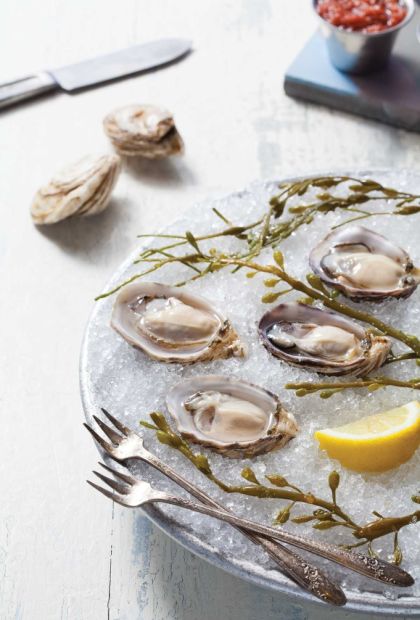LOOKING AROUND
A behind-the-scenes look at the property—from the décor to the history.
Read On 
The first oyster eater must have been curiously courageous, but then the same is true for many other culinary delicacies. Beyond the look and acquired silky—or to some folks slimy—texture, they are beautiful in their simplicity.
Oysters are unique and not because you might find a pearl, which isn’t likely, at least not in the edible variety. They are a type of food that straddles the fence between high-class and low-country fare. From Rockefeller to raw to fried, they have a transformative quality depending on the service style and preparation.
If you are eating them at a fine dining restaurant with mignonette sauce and white linen napkins, sipping Champagne or absinthe, watching the sunset … there is a certain type of sophistication in the whole process of ordering and eating. If they are fried and served in a po’boy or topped with Tabasco sauce and paired with a cold brew, then the whole mood changes.
No matter the preparation, oysters have fans and foes. Many love them, some won’t eat them at all, and others might need a few encouraging words before they will broaden their palate. With cooler months ahead, we asked Terranea Resort’s Executive Chef Bernard Ibarra to crack open some valuable information on purchasing, preparing and enjoying these ocean gems.
Best time to buy oysters?
“When you feel like eating [them]. Really the best time is during non-spawning season—or when water temperature is cooler.”
Is bigger always better?
“Not necessarily. All depends on how you want to eat them … whether cooked, raw or as a shooter. I personally prefer smaller oysters: briny, shiny, moderate mineral taste.”
Are oysters nutritious?
“Yes, oysters have a VIP list of ingredients and nutrients: low in fat, high in protein, iron, vitamin B12, zinc and copper. Like everything, they should be consumed in moderation.”
Does the “R method” (months that include an “R”) really ensure safety, as the oysters are not spawning? Should you not eat a spawning oyster?
“I do believe that the ‘R’ reference, came to us from ancient times when there was no refrigeration available, but we continue to hear this nowadays. I do feel that the oyster industry is so well regulated that it is perfectly safe to consume those beautiful bivalves year-round. On the other hand, eating spawning oysters is not a pleasant culinary trip, per se. During that time, they taste milky instead of being nice, firm with a taste of minerals.”

Where is the best place to buy oysters?
“At your fishmonger’s. The tags attached to the oysters will let you know the origin, harvesting time, etc.”
Do the waters where they are harvested need to be certified?
“Waters are constantly regulated and analyzed. It is probably the best industry that monitors and forecasts conditions, making oyster consumption a very safe hobby/pleasure year-round.”
Is it true that 98% of all oysters are farm-raised?
“It is between 95% and 98%. Buying and consuming oysters issued from farms located in different parts of the country’s/world’s coast lines allows us to look at oysters like we look at mushrooms that exude a smell of the terroir—different textures and specific flavors reminiscent of where they were farmed.”
How do you know if they are fresh?
“Poke the oyster lightly around the lips. The oyster should retract. Double-check with the smell, it should smell like the ocean. If it smells bad or does not retract, discard.”
What are some signs to look for when buying and serving?
“Discard oysters with broken shells or damage. The shell should be glossy white in color. When open, meat should be plump. Bad oysters are dry and withered and sometimes with a cloudy appearance. The smell should be fresh and mild and not strong, offensive or pungent [with a] fishy smell.”
How should oysters be opened and cleaned?
“They should be opened just before serving. They should be washed a little—scrubbed—as to make sure there are no foreign or unwanted particles. The oyster has to be held firm with a towel, then gradually apply pressure, oscillate around the hinge, and once the knife comes in go straight for the adductor and make a clean cut. Open the oyster, making sure not to break any shell and lose any of its liquor.”
What is the best way to prepare oysters?
“For me, personally, simply freshly shucked, a little hot sauce or maybe a small drop of mignonette, but not much. I like them as plain as possible; then I close my eyes and taste it.”
What is best to serve with oysters?
“On ice, with hot sauce, mignonette or lemon. Keep as plain as possible.”
Any preferred pairings?
“For raw oysters, Sancerre or txakoli wine—a young acidic wine from the Basque Country—perfect with shellfish on a summer night. Cava, Champagne or dry sherry are also great choices.”
What are we missing?
“That oysters are aphrodisiacs, or maybe that’s just the view at Terranea.”
Written by Kara Mickelson | Photographed by Alan De Herrera